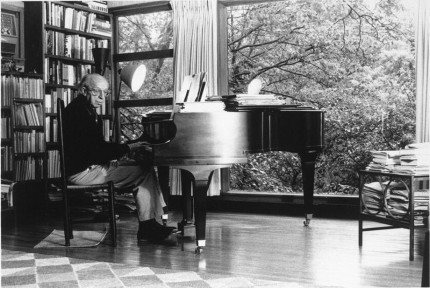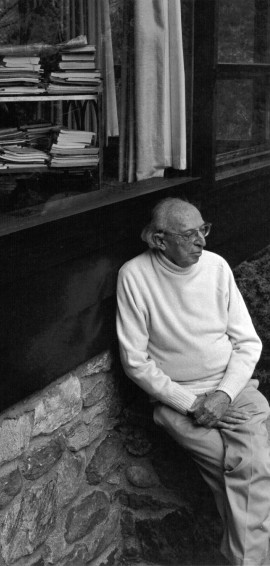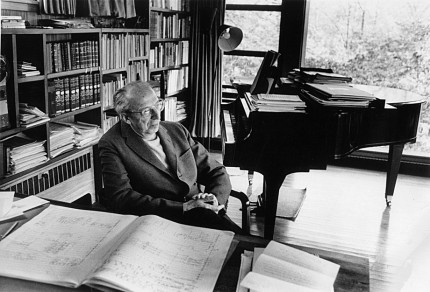Timeline
Aaron Copland: Timeline of a Musical Life

Aaron Copland at the Piano
(compiled by Michael Boriskin)
1900—Born on November 14 in Brooklyn to Sarah Mittenthal and Harris Copland, the youngest of five children (Ralph, Leon, Laurine, and Josephine)
1906—Attends Public School 111 in Brooklyn
1909—Begins to make up songs at the piano
1910-13—Attends summer camp (Camp Carey at Wilkes-Barre, PA)
1911—Earliest existing piece of music; begins piano lessons with sister Laurine
1914—Begins studies with first professional piano teacher, Ludwig Wolfsohn in Brooklyn
1916—Hears first symphony concert in Brooklyn
1917—First public performance as a pianist
1918—Graduated from Boys’ High School, Brooklyn
1917-21—Studies harmony and counterpoint with Rubin Goldmark
1919-21—Studies piano with Clarence Adler

Aaron Copland
1921—Enrolls at newly-established American Conservatory at Fontainebleau in May; attends harmony class of Nadia Boulanger and begins composition studies with her in October
1922—First work published (by Durand): Le chat et la Souris (composed 1920); writes the Passacaglia for piano and first large-scale work, the ballet Grohg (revised 1932)
1924—First important article published, Gabriel Fauré, A Neglected Master (The Musical Quarterly)
1925—First major performances of an orchestral work, Symphony for Organ and Orchestra at Aeolian Hall (Nadia Boulanger, organist, with Walter Damrosch conducting the New York Symphony) and in Boston (with Serge Koussevitzky conducting the Boston Symphony Orchestra); first visit to MacDowell Colony to work on Music for the Theatre; receives the first-ever Guggenheim Memorial Fellowship (renewed in 1926); writes first of many articles for Modern Music
1927—First major performance of Copland as pianist, World Premiere of his Piano Concerto (composed 1926) with Koussevitzky and the Boston Symphony; begins lectures at New School for Social Research, New York (continuing for ten years, eventually developing some of these into his book What to Listen for in Music)
1928—Initiates Copland-Sessions Concerts with composer Roger Sessions, an important series mostly in New York devoted exclusively to contemporary music (continuing to 1932, averaging two concerts per season); joined the League of Composers (remaining a member until 1954); helps to establish Cos Cob Press, devoted to publishing works by young American composers; completes first important chamber work, Vitebsk
1929—Wins the RCA Victor Composers’ Competition with Dance Symphony (along with Ernest Bloch, Robert Russell Bennett, and Louis Gruenberg); completes Symphonic Ode
1930—First visit to Yaddo, Saratoga Springs, NY; composes first major work for solo piano, Piano Variations; Organizes Festival of Contemporary Music at Yaddo (and a second one in 1932)
1932—First visit to Mexico, arranged by Carlos Chavez, which includes first all-Copland program (organized by Chavez at the Conservatorio Nacional de Music on September 2nd: Two Pieces for String Quartet, Piano Variations, Two Pieces for Chorus, and Music for the Theatre); joins the Board of Directors of the League of Composers; joins a social and professional collective called Young Composers’ Group (including Arthur Berger, Henry Brant, Lehman Engel, Vivian Fine, Bernard Herrmann, Elie Siegmeister, and others)
1934—First performance of a staged work, the ballet Hear Ye! Hear Ye! by Ruth Page Ballets (in Chicago)

Aaron Copland at his Desk
1935—Teaches for the first time at Harvard, replacing Walter Piston on leave in spring semester; organizes five concerts at the New School, each devoted to the music of one composer (Harris, Thomson, Sessions, Piston, and Copland)
1936—Writes regular column (“Scores and Records” for Modern Music, which continues until 1939); completes El Salon Mexico
1937—Composes The Second Hurricane, a "play-opera" for the Henry Street Settlement Music School in New York City, directed by Orson Welles, to be performed by children and adults
1938—Publisher becomes Boosey & Hawkes, to which he was recommended by Benjamin Britten; helps to establish American Composers’ Alliance (serving as President between 1939 and 1945); helps to found Arrow Music Press (incorporating Cos Cos Press) with Engel, Blitzstein, and Thomson
1939—Writes first film score to The City, a documentary by Ralph Steiner and first score for a feature film, Of Mice and Men; helps to found American Music Center; publishes first book, What to Listen for in Music
1940—Invited by Koussevitzky to teach at the first summer of the Berkshire Music Center at Tanglewood (continuing until 1965, and including various administrative positions)
1941—Second book, Our New Music, published; four-month South American tour for the Committee for Inter-American Artistic and Intellectual Relations
1942—Completes A Lincoln Portrait, commissioned by conductor Andre Kostelanetz, and Fanfare for the Common Man, and composes the ballet Rodeo, commissioned by Agnes de Mille; elected to the Music Department of the National Institute of Arts and Letters
1944—Receives Academy Award nomination for his film score to The North Star; returns to Harvard in the spring for five talks as Horace Appleton Lamb Lecturer
1945—Wins Pulitzer Prize in Music and the New York Music Critics Circle Award for Appalachian Spring, a ballet by Martha Graham composed in 1944
1946—Completes one of his largest works, Symphony No. 3 (begun 1944), which wins the New York Music Critics Circle Award; elected a member of ASCAP
1947—Four-month tour of Latin America for the U.S. Department of State; gives up New York City apartment and loft studio, and moves to Sneden’s Landing, Rockland County, NY; begins Clarinet Concerto for Benny Goodman
1948—Becomes Director of the League of Composers (remaining until 1951)
1949—European tour
1950—Wins Academy Award for Best Original Musical Score for the film The Heiress; sixth visit to the MacDowell Colony, during which he begins work on the Piano Quartet, his first 12-tone work; completes Twelve Poems of Emily Dickinson
1951—Receives Fulbright Fellowship for six-month stay abroad, including a short residency at the American Academy of Rome and first trip to Israel; conducts work by another composer for the first time (Diamond’s Rounds, in Italy); gives Charles Eliot Norton Lectures at Harvard (first native-born American to hold Poetry Chair), published in 1952 as Music and Imagination
1952—Begins work on The Tender Land; buys his first house, Shady Lane Farm in Ossining, where he lives for eight years
1953—Becomes embroiled in Washington’s anti-Communist hysteria, and is subpoenaed to testify at McCarthy Congressional hearings, as a result of which several of his engagements are canceled; first book about Copland published, written by composer-critic Arthur Berger
1954—World Premiere on April 1 of The Tender Land at the New York City Opera; elected to membership in the American Academy and Institute of Arts and Letters
1955—Six months in Europe; Julia Smith’s biography of Copland published
1956—Awarded Gold Medal of the American Academy and Institute of Arts and Letters; receives first Honorary Doctorate (from Princeton, U.); six months in Europe
1957—Composes Orchestral Variations (a symphonic transcription of his Piano Variations); completes monumental Piano Fantasy (begun in 1955)
1958—New York Philharmonic conducting debut
1960—Buys Rock Hill in the Town of Cortlandt, which was to be his home for the remaining 30 years of his life; fourth book published, Copland On Music
1961—Receives MacDowell Colony Medal of Honor, for distinguished service in the field of music; becomes President of MacDowell Colony (serving until 1968)
1962—Writes Connotations for Lincoln Center Inaugural Concert by the New York Philharmonic; composes Down A Country Lane, is published in Life magazine on June 29
1964—Awarded Presidential Medal of Freedom, America’s highest civilian honor
1965–66— Wrote, hosted, and performed on a 12-part public television series, Music in the Twenties
1967—Writes Inscape, last major orchestral work, for the New York Philharmonic’s 125th Anniversary
1968—The New Music, 1900-1960 is published (a revision of his Our New Music)
1970—Receives Commander’s Cross of the Order of Merit from West Germany and the Howland Memorial Medal from Yale University; awarded membership in Institut de France and Britain’s Royal Philharmonic Society
1971—Composes the Duo for Flute and Piano, his last important work
1975-76—Gives interviews to Vivian Perlis for her Oral History Project in American Music at Yale University, which develop into their collaboration on Copland’s autobiography
1977—Copland’s complete piano music performed in concert for the first time (by Leo Smit)
1979—Receives Kennedy Center Honors; first recording of Copland’s complete piano music (by Leo Smit)
1980—“Wall-to-Wall Copland,” a day-long marathon concert, at Symphony Space, New York City
1981—Department of Music at Queens College of the City University of New York renamed Aaron Copland School of Music
1984—First volume of memoirs appears (Copland: 1900 Through 1942, written with Vivian Perlis)
1986—Awarded both the Congressional Gold Medal (by “act of Congress,” one of America’s highest civilian honors) and the National Medal of Arts (bestowed by President Ronald Reagan)
1989—Second volume of memoirs published (Copland: Since 1943, with Vivian Perlis)
1990—Dies on December 2 at Phelps Memorial Hospital Center, North Tarrytown, NY; ashes are scattered at Tanglewood